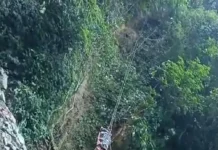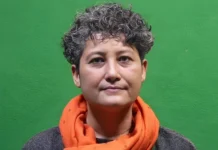From a Correspondent
NIRJULI, Jan 21: The fast-changing present life vis-a-vis transitional culture calls for preserving the Nyishi indigenous knowledge enriched with rich history, said Dr Alex Aisher, anthropologist of University of Sussex, UK.
“You have a very special history, unique traditions and cultures enlivened with environmental gospel even today, though I experienced them all during 2002-03 which could prove to be great source of your identity,” he said while addressing a conference of the Nyishi Festival Committee (NFC) as guest of honour in Nyikum Niya Hall here on Saturday.
“The choice is yours,” he said, and quoted a Nyishi gentleman telling him that they have no written history except oral. “It is high time for the Nyishis to have their own Rig Veda like the Hindus for their knowledge to benefit the humanity,” the scholar said.
“Have you ever thought why seasonal birds appear? Why you take up shifting cultivation?” questioned Dr Aisher, who is credited with conducting in-depth research on Nyishi cosmology. “This is nothing but a ‘give and take relation’ between man and nature as mountains respond to humanity and vice versa,” he said.
Mostly women take up cultivation. But during harvesting of grains, nature blesses with snow grains atop the hills when the birds fly into human inhabited areas and their chirping sound enhance the beauty of nature.
As you all are aware that the mountains are sacred and there is a border between the mountain and human habitation. But like the birds fly into human inhabited areas, wild animals too come to get preyed. This is nothing but exchange between the mountains and the human beings. This is lucidly explained even in village level conception to protect and preserve the environment and wildlife by prohibiting killing of specific wild animals and birds, he reasoned.
Dr Aisher is right as indigenous Arunachalees, originally known as hunters and gatherers, used to go for hunting in olden days and gather foods from the wild to preserve through indigenous techniques for months together for survival. Arunachal experiencing heavy rain falls for about six to seven months hardly offer few months for such activities to sustain life.
A global conference on ‘Hunting and gathering societies’, conducted in 1966 in the World Museum in Vienna, had painted a true picture of this Himalayan state by and academician from the RGU’s Tribal Studies department. The conference was a joint initiative of the Institute for Social Anthropology, Austrian Academy of Sciences, Vienna University’s Social & Cultural Anthropology department, the Anthropological Society Vienna and the International Society for Hunter Gatherer Research.
“We always look at nature from our viewpoint and necessities, but many things would be clear if we try to introspect the ecology from nature’s angle,” he said while explaining the meaning of perspectivism.
Interestingly, Dr Aisher on a research mission in India met Prof Nikhilesh Kumar at NEHU, Shillong, in 2001 and coincidentally NFC secretary Amit Bengia was doing research under him. Bengia during interaction while explaining about the Nyishis, the largest among the numerous indigenous communities of Arunachal Pradesh, had suggested working on Nyishis as no tangible research was conducted on the tribe till then. The Nyishi Elite Society (NES) pitched in with support and obtained a research visa. This had facilitated his journey in 2002 to the unknown land walking on foots escorted by former minister Kahfa Bengia, Amit Bengia and other local assistants to Koloriang, Menge, Sarli and Parsi-Parlo.
Explaining his journey during those days without road, he recalled about a hanging bridge with narrow strip to be walked very carefully while holding the wire above, but if one sleeps by chance would fall in a stream flowing hundreds of feet below to ensure death, he said with his face reflecting his worst experience.
“Chanting of traditional hymn by a nyibu (shaman priest) of the team was heard as I crossed with bated breath. It proved human solidarity even in the wilderness. This was enough to convince me that the Nyishis are fantastic people with great hearts,” he said, adding “even in the upper land they extended unbelievable hospitality. Every evening sitting with the house owner to listen to the past stories over opo (local brew) used to enrich my knowledge,” Dr Aisher said.
“After attending Longte festival in Parsi-Parlo and touring the nearby villagers, I focused my research based at Koloriang. However, on return to Nirjuli, my meeting with nyibu Bengia Takio proved to be rewarding as he was highly knowledgeable with vivid knowledge of Nyishi history, their migration as well as that of Abotanis,” he said.
Bengia Chongpi of the NERIST and the first female nyibu, Heri Para, an amazing elderly person with seven sons and vast knowledge on Nyishi philosophy, whom I met during Nyokum festival in Kimin, continued to enrich my knowledge. The journey was tough but rewarding with 100 video and 40 oral recordings, said Dr Aisher.
Nyishis were born centuries or millennium ago but their institution of nyibus and nyijiks concept believed to have started at Narba settlement as they are born not made, he said and advocated that the NFC could introduce scholarship for an outstanding project to study the location of Narba, their migration route and wisdom to serve as encyclopedia for others to learn, especially the next generation. Like the concept of European literary culture centering The Odyssey, said Dr Alex, before announcing that outcome of his studies would be published as a series of articles have been published and more are in queue, whose webpage link would be given to NFC, to the thunderous applause of the gathering.
NES President Bengia Tolum as chief guest expressed concern that materialism was impacting socio-cultural identity of the Nyishis as the tribe living in isolation was ignorant of the outside world. When still oral history, many cultural and traditional aspects are alive, the intellectuals should work to document to protect and preserve them least repent like the Maoris of Polynesia migrated to New Zealand, who had lost everything after Europeans invaded New Zealand, but now trying to revive their lost glory.
“Let the thesis be made public for antithesis and synthesis through criticism for right thing to emerge,” he said, adding the dresses (Pomo) are not identity of a tribe but their culture for which every member has to shoulder responsibility.
Expressing appreciation for Dr Aisher for his invaluable service, he asked the NFC to consider granting scholarship for preparing a document while cultural experts should deliver lectures for the GenNext to learn.
Tolum, who was a teacher in Yazali, and served scholar Fürer Haimendorf Christoph, from the University of California, while conducting in-depth field studies in Yazali on Arunachal tribes in the ’80s, quoted him expressing dismay that Hindi and English are the mediums of education, saying no society could progress if mother language is not taught to the children.
“The GoAP policy on medium of education is defective under mining local dialects while school syllabus does not include any cultural aspect,” he said, quoting former union minister Daying Ering of repeatedly advocating to protect culture practically.
“If not, days will come when you have to prove yourself as Nyishis,” he cautioned.
Applauding Dr Aisher for his strenuous efforts to enliven age-old history of the Nyishis, NFC chairman Tarin Dakpe said that the unique endeavour included linking the Nyishis with the global community.
Informing about the golden jubilee celebration of Nyokum Yullow at Yazali this year, Nyishi Art & Culture Welfare Society Chairman Bengia Tabb invited Dr Aisher to attend.
Tabb, responding to a question on Nyishi script, told this editor later that Roman script with Devanagari pronunciation has been adopted and the works are in progress.
Introducing him earlier, Amit Bengia said he was awarded PG research studentship (2001-05) by the Economic & Social Research Council, UK – one of the two UK anthropologist to be awarded prestigious British Academy postdoctoral fellowship (2007-11); nominated Teaching Champion-2014 by University of Sussex School of Global Studies; awarded first ever Cross-University Teaching Award-2014 for outstanding undergraduate teaching & support’ in University of Sussex; lead editor (2016) for special issue ‘Conservation, Symbolism & Imagination: Human-Nature Interactions in Global South, published in leading international journal Conservation & Society which brings together works of leading anthropologists & environmental historians across Global South and develops a new framework for place-based conservation through a multispecies lens. Moreover, he is first foreign scholar after a gap of almost four decades to conduct extensive long term ethnographic field works in Arunachal Pradesh.
Many speakers highlighted various aspects of the Nyishis, including Dr Tana Showren, first professor of the community and senior officer (Kra-Dadi DC) Pige Ligu, who also assisted Dr Aisher in research works.
The NFC would continue to work under the guidance of Dakpe and Bengia, the conference unanimously concluded.



